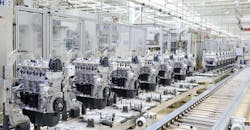The U.S. manufacturing sector generated 244,000 new jobs last year as a result of reshoring and foreign direct investment (FDI) activity, according to the Reshoring Initiative’s 2024 Annual Report. Since it began tracking global manufacturing and U.S. jobs in 2010, Reshoring Initiative credits those reshoring and FDI for creating 1.7 million new jobs over the past 15 years.
“Reshoring” describes the business strategy of transferring manufacturing operations to the U.S. from foreign locations.
The 2024 results reflect the influence of U.S. tariffs on manufacturing activity and supply chains, according to Reshoring Initiative, a not-for-profit organization that works to promote U.S. manufacturing by helping businesses to assess the cost of offshore production and demonstrating to them the benefits of domestic manufacturing, including cost savings, quality control, and supply chain resilience.
The Reshoring Initiative is a not-for-profit organization focused on growing U.S. manufacturing by helping businesses to assess the cost of offshore manufacturing and demonstrating to them the benefits of domestic manufacturing, including cost savings, quality control, and supply chain resilience.
The 2024 annual report is available for download.
“Reindustrializing America is impossible without reshoring, FDI, and strong industrial policy,” stated Reshoring Initiative president Harry Moser. “Our data shows tremendous progress, but the U.S. must address workforce shortages and manufacturing cost disadvantages to maintain this momentum.”
In addition to the 2024 job totals attributed to reshoring and FDI, the annual report details that reshoring by U.S.-based businesses last year exceeded foreign direct investment by the largest margin recorded to date.
The group classified 88% of the 244,000 new jobs last year as belonging to high- or medium-tech manufacturing sectors, but that figure has risen to 90% of the new jobs in the early tracking of 2025 reshoring activity.
It recognized that low-tech industrial jobs remain “under-reshored, leaving U.S. supply chains vulnerable for mass-market consumer goods.”
The industries leading the reshoring activity in 2024 were computer and electronics, electrical equipment (including EV batteries and solar), and transportation equipment.
Most of the new manufacturing activity (reshoring plus FDI) is being drawn from South Korea, China, and Germany, according to the report. Texas, South Carolina, and Mississippi are the top states where businesses are placing their reshored operations.
As for U.S. tariffs on imports of manufactured goods, the Reshoring Initiative reported that tariffs are rising as a motivating factor for the businesses making the reshoring decision – up by 454% in 2025 over 2024. At the same time, government incentives are receding (-49%) as a motivator, as formerly available incentives are phased out.
Reshoring activity in the current year may not sustain the job growth recorded for 2024. Year-to-date figures project a drop of about 70,000 reshored/FDI jobs, to 174,000 announced jobs for 2025. “Many large tentative announcements are contingent on clearer signals from the administration,” according to Reshoring Initiative.
The group identified the factors that may impede reshoring and FDI activity, starting with U.S. manufacturers requiring more skilled workers to staff their operations: U.S. manufacturing apprenticeships rose 83% over the past decade, but far more skilled workers are needed to sustain reshoring growth.
Other risks cited include “policy uncertainty” that delays investment planning, retaliatory tariffs that could undercut U.S. export efforts, and the continuing high cost of U.S. manufacturing, which Reshoring Initiative claims is 10 to 50% higher than competing offshore markets.
Early 2025 data projects a drop to 174,000 jobs announced for this year — but that figure could increase if businesses gain confidence in the permanence of new tariff and industrial policies. Some large reshoring or FDI announcements are contingent on clearer signals from the administration, RI reported.
Broadly, the Reshoring Initiative argues that continued progress for growing domestic manufacturing requires “a true national industrial policy” that emphasizes skilled workforce development (based on apprenticeships); a weaker USD currency (-20%) to improve the cost-competitiveness of U.S. manufacturers; and “smarter” application of tariffs and Total Cost of Ownership (TCO) analysis, to make reshoring consistent.
“The U.S. can’t count on tariffs alone to restore its industrial leadership,” according to Moser. “It must level the cost playing field and build a skilled workforce to truly compete and win globally.”
